on lots of electric trucks. . .Grand Highlander. . .atomically analyzing additive. . .geometric designs. . .Dodge Hornet. . .
EVs slowdown. . .Ram’s latest in electricity. . .the Grand Highlander is. . .additive at the atomic level. . .advanced—and retro—designs. . .the Dodge Hornet. . .Rimac in reverse. . .
About Those Electric Trucks

Yes, it goes without saying that this is an atypical pickup truck. (Image: Tesla)
No, the headline doesn’t go to the point of the Tesla Cybertruck, which was introduced in November 2019 and was to go into production in late 2021. But soon. Soon.
Rather, to the EV trucks from the Traditional Three.
Ford was first out of the gate with the F-150 Lightning, which went into actual production in April 2022. It was so popular that Ford had, at times, to pause orders. This past summer it expanded the Rouge Electric Vehicle Center to tool it to build as many as 150,000 of the electric pickups per year.
The company was running three shifts. In early October it announced it was cutting one of the shifts. It mentioned such things as supply chain constraints and quality checks.
There are also reports the truck isn’t selling as well as had been intended.
Through Q3 Ford sold 12,260 Lightnings, a number that is not particularly robust.
And after its Q2 2023 earnings call Ford CEO Jim Farley said, “We have been surprised, frankly, at the popularity of hybrid systems for F-150.” So there was a slight shift in its messaging. And so the F-150 Hybrid is garnering more attention from the corporation.
While Rivian aggregates its numbers so it is not clear what the breakdown is for the R1T (pickup), R1S (SUV) or cargo van, it did report that through Q3 it delivered 36,150 vehicles. Not apples-to-apples by any means, but still a bit of context when you consider that F-150 number. So there should be little surprise that the Hybrid now matters.
Later, Later
Meanwhile, GM announced that it was going to be pushing back the production of the Chevrolet Silverado EV and the GMC Sierra EV at the Orion Assembly Plant by a year, to late 2025.
The Detroit Free Press quoted GM spokesman (and former editor of on Automotive’s predecessor publication) Kevin Kelly: “We’re looking at EV demand and the trendline for EVs is stabilizing. It is not rising as fast as originally forecasted.”
GM probably wishes it still had some hybrids around.
The good news for Stellantis is that it announced the Ram 1500 REV wouldn’t be available until Q4 2024, so it has time to adjust its forecasts as necessary. (See next item.)
And There’s the Professor. . .
Which brings us to comments made by Rahul Kapoor, management professor at the Wharton School who specializes in industry disruptions and related ecosystems predicated on new technologies and business models.
Speaking on “Wharton Business Daily” in mid-October during the UAW strike against the Traditional Three Kapoor said:
“We’ve been at the emergence of the EV market for more than two decades, and we were just about to start the take-off of the growth process here in the U.S., and now we are in the midst of the strikes.”
But the strike notwithstanding, Kapoor said, “We are in an environment of high interest rates, high inflation, and consumers are taking more of a wait-and-see approach in terms of their decision whether to adopt EVs. The ones who wanted to get in have already gotten in earlier on.”
Seems like the road to EVs is going to be longer than some evidently anticipated.
///
“Electric” or “Electrified”?

The 2025 Ramcharger. Look closely at the front and rear quarter panels. You’ll see a fuel (energy?) filler door on each. The front is for electricity. The back gasoline. (Image: Stellantis)
“The ultimate battery-electric truck.”—Tim Kuniskis, Ram Brand CEO, on the 2025 Ram 1500 Ramcharger.
Sort of.
The Ramcharger features:
- 250-kW front and 238-kW rear electric drive modules (EDMs), each of which combines the motor, gearbox and inverter. Check
- 92-kWh liquid-cooled battery. Check
- 400-V fast-charging capability at up to 145 kW providing up to 50 miles of range in about 10 minutes. Check
- Vehicle-to-vehicle and vehicle-to-home bi-directional charging. Check
- On-board power panel in the bed providing up to 7.2 kW. Check
- 663 hp and >615 lb-ft of torque. Check
- 14,000-pound towing capacity. Check
- 2,625-pound payload capacity. Check
- 0 to 60 mph time of 4.4 seconds. Check
- 690-mile range. Check
Wait a minute.
690-mile range?
Yes, that’s what they’re saying.
That’s a long, long way for something powered by electricity.
Max ranges:
- Ford F-150 Lightning: 320 miles
- Silverado EV: 450 miles
- Cybertruck: 500 miles
The currently available electric vehicle with the longest range is the Lucid Air Dream, at 520 miles and it is a sleek uber-luxe sedan, not something with a box on the back .
What Is It?
Which brings us back to that description of this being “The ultimate battery-electric truck.”
Yes, it has electric drive modules that drive the wheels.
Yes, it has a pouch-cell battery pack format that’s under the floor.
Yes, the EDM on the front axle has an automatic wheel-end disconnect that allows the front wheels to spin freely under certain conditions, thereby increasing vehicle efficiency.
But 690-mile range?
And this is when the “Sort of” comes into play.
The Ramcharger has 145 miles of electric-only range.
The other 545 miles?
Well, the wheels are electrically driven by those EDMs at all times.
But the truck makes use of a 130-kW generator. . .which is powered by a 3.6-liter V6 Pentastar engine.
As in gasoline engine.
Which seems to mean the truck is really a hybrid. A series hybrid:
There are different ways to combine the power from the electric motor and the engine. Parallel hybrids—the most common HEV design—connect the engine and the electric motor to the wheels through mechanical coupling. Both the electric motor and the internal combustion engine drive the wheels directly. Series hybrids, which use only the electric motor to drive the wheels, are more commonly found in plug-in hybrid electric vehicles.—Alternative Fuels Data Center, U.S. Dept. of Energy
The Electric Ram
The Ram 1500 REV is an electric truck.
It has dual 250-kW EDMs, one in the front and one in the pack, that are powered by either a 168-kWh battery pack that’s standard, or a 229-kWh battery pack that will provide an estimate 500 miles of range. It has 800-Volt DC fast charging capability (up to 350 kW) that provide 110 miles of range in about 10 minutes.
The Ram 1500 REV offers vehicle-vehicle to-vehicle, vehicle-to-home and vehicle-to-grid bi-directional charging.
Both the REV and the Ramcharger are based on the STLA Frame platform, which was engineered specifically for electric vehicles.
But there is no internal combustion engine for the REV.
Tim Kuniskis says that when everything is right—infrastructure, costs, etc.—full electric vehicles are going to take off so that there will be sales charts with graphing that resembles a hockey stick.
But when that is going to happen—well, he doesn’t know.
But he does know that people are still concerned with electric vehicle range.
So that’s where he says the Ramcharger excels.
The standard fuel tank size for a gasoline-powered Ram 1500 is 23 gallons. The combined fuel economy for a 2024 Ram 1500 with a Pentastar V6 Etorque is 22 miles per gallon. Which means a range of 506 miles.
That’s the sort of range people are familiar and comfortable with.
So the 690 miles that the Ramcharger provides is beyond comfort.
What’s more, Kuniskis points out that the 145 miles of electric-only range that the Ramcharger provides is more than sufficient for most day-to-day driving needs. It is conceivable that the generator in the truck will be the least-used element of the vehicle.
Still, at what is still arguably an early stage of electric pickups, referring to the Ramcharger as an “EV” and not a “hybrid” could cause consumer confusion (and competitor criticism).
As this is something that is not going to appear until late in 2024, there is certainly plenty of time to adjust the messaging strategy.
///
Clever Nomenclature

The 2024 Silverado EV makes much of its underlying structure. (Image: Chevrolet)
Speaking of EV pickups. . .
“Ultibody.”
That, says Matt Perelli, lead development engineer for the Silverado EV, is what the team referred to the structure for the electric pickup.
The Ultium battery pack (200+ kWh; 24 modules) is integrated into the truck’s frame, thereby enhancing the structure of the vehicle, which is certainly a beneficial for the truck, especially the WT (work truck) version, which has the ability to handle 10,000 pounds of towing and 1,400 pounds of payload. The WT propulsion system provides 510 hp and 615 lb-ft of torque. It has a 450-mile range.
While driving an unladen pickup (the Silverado EV WT has a 5-ft, 11-in. bed) can be an experience that brings an unpleasant amusement park ride to mind when on an rough surface, the lower center of gravity provided by the Ultibody approach makes the ride and handling of the truck something that doesn’t cause that coffee in the cupholder to make its way into the center storage compartment.
///
2024 Toyota Grand Highlander Limited
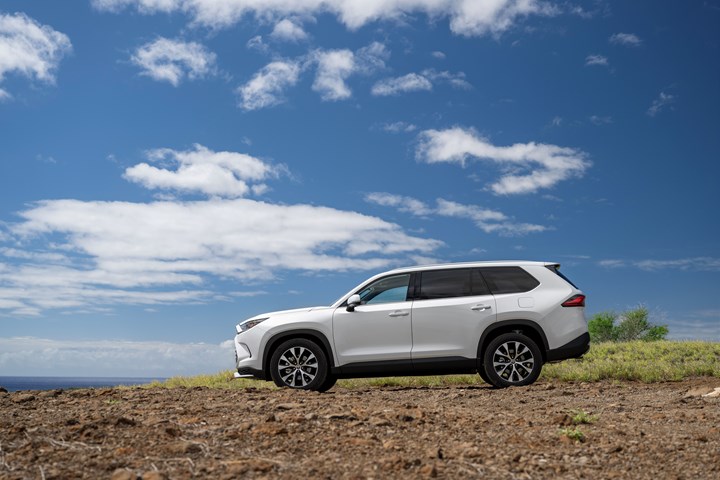
2024 Toyota Grand Highlander: When you need something that has plenty of wide-open spaces. (Image: Toyota)
In 1957 Toyota began selling cars in the U.S. The Toyopet. Things, of course, have certainly changed since then.
Consider the dimensions of the Toyopet:
- 169 inches long
- 66 inches wide
- 60 inches high
- 99.6-inch wheelbase
Of course, the landscape was different back then. Volkswagen had established its U.S. operation, Volkswagen of America, in 1955, and while there were still the big, brash sedans rolling out of dealerships with Big Three badges, there was a slow-but-sure build-up of people buying diminutive cars like the Beetle.
So the Toyopet made sense.
However, with time, things have gotten bigger and the things that were smaller—like the Toyopet and even the Beetle—have become the stuff of history.
And a perfect example of this is the latest vehicle from Toyota, the Grand Highlander.
Consider its dimensions:
- 201.4 inches long
- 73.3 inches wide
- 70.1 inches high
- 116.1-inch wheelbase
The Grand Highlander can swallow plenty of cargo:
- 97.5 cubic feet behind the first row
- 57.9 cubic feet behind the second
- 20.6 cubic feet with all rows (yes, there are three) up
It would be an exaggeration to say that it could accommodate a Toyopet (it couldn’t), but the imposing size of this SUV certainly seems as though it could.
And interior space is what this vehicle is really all about, as in having a third row that can actually seat full-size adults without having them feel as though they are in a penalty box.
The Toyota Highlander “seats” seven or eight, as the Grand variant does.
But this puts that in perspective.
Highlander passenger volume:
- 144.5 cubic feet without moonroof
- 142.2 cubic feet with moonroof
- 138.9 cubic feet with panoramic moonroof
Grand Highlander passenger volume:
- 149 cubic feet with panoramic moonroof
- 153.3 cubic feet with normal roof
So the “Grand” moniker is earned. Those seated in it are, well, seated.
Another thing to think about regarding the Grand Highlander in relation to earlier days of Toyota.
The first Prius hybrid vehicle arrived in the U.S. in 2000 (it was launched in Japan in 1997).
Its propulsion system: 72 hp.
But it was a small car:
- 163 inches long
- 66.9 inches wide
- 58.3 inches high
- 100.4-inch wheelbase
About the size of a Toyopet.
Toyota hybrids have gotten bigger and more powerful over the years.
The Grand Highlander is available with three powertrain options, two of which are hybrids.
There is the base 2.4-liter four-cylinder turbo that produces 265 hp.
Then there are:
- Hybrid, which has a 2.5-liter four that, combined with its electric motor, produces a system horsepower of 245
- Hybrid MAX, with a 2.4-liter turbo and motor system for 362 hp
Yes, a substantial SUV with more than five times the horsepower of that first Prius.
We’ve established that it is roomy. It has power suitable to its size. (And the least fuel efficient, a gas-powered Limited or Platinum trim with AWD is 20/26/22 city/highway/combined mpg, while the most fuel efficient is a hybrid XLE with FWD: 37/34/36 mpg.) It has amenities, both comfort (nice seats, I must say) and convenience (a standard 12.3-inch touchscreen for infotainment purposes).
All in, it deserves the “Grand” moniker.
///
AM Analyzed at the Atomic Level
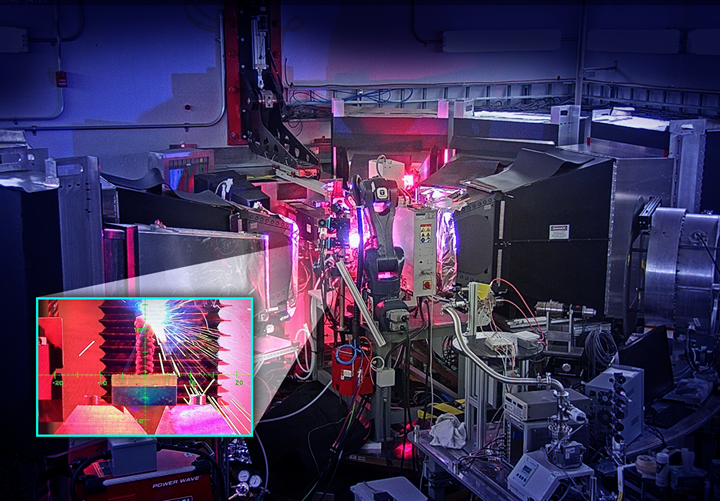
Setup at ORNL that uses neutrons to analyze the structure of parts made with additive manufacturing.(Image: ORNL/Jill Hemman)
According to the American Iron and Steel Institute, about 54% of an average vehicle is made of. . .Steel.
One of the manufacturing processes for vehicles that holds increased promise for automotive is additive manufacturing (AM). This is particularly the case for making metal components with AM.
However, there is a bit of a challenge. To perform additive, the material used is heated, applied, cooled, then another layer that’s applied on top goes through the same sequence. All of which puts residual stresses in the final part should it be made of metal. Which can be problematic during the use of said part.
The tricky thing is determining where those stresses are. And then once identified and understood being able to design in the stresses so they can be managed.
This led to a two-year research project at the Oak Ridge National Laboratory (ORNL) Material Science and Technology Div. aimed at figuring this out.
And to that end they created the “OpeN-AM” platform, which allows the researchers to observe and measure the creation and location of residual stresses in a 3D printed part.
“There’s only so much you can learn about a material after it’s processed using traditional characterization tools. The goal of the OpeN-AM project is to provide a new, more advanced way of characterizing the process that enables us to see inside the materials as they’re being produced.”-- ORNL project lead Alex Plotkowski.
It’s worth noting—if for no other reason than to know how complex this undertaking is—that this involves using the ORNL Spallation Neutron Source, infrared imaging and computer modeling.
Yes, they’re studying at the atomic level.
Back to Steel
The ORNL researchers are using AM to make parts with low-transformation temperature (LTT) alloy steel. Which is typically used as a filler material in welding.
Which made us wonder why they’re using it. After all, a part is a part and a filler material is. . . .
So we asked Plotkowski.
Who told us:
“Yes, LTT was originally designed as a filler metal to help control residual stresses in steel welds. However, we are looking at is as an opportunity for construction of bulk components, where we can utilize its characteristics to help manipulate the residual stress distribution. More generally, a primary concern for selecting materials for additive manufacturing is the ‘weldability’ or ‘printability.’ Since materials historically designed as filler metals are often made specifically to be weldable, they are generally good choices for AM, and we are now using a lot of materials that might have been historically considered fillers as the main material for large components. Of course, beyond just the weldability constraint, we care very much about other properties, such as strength, creep resistance, or corrosion resistance.”
While all of this may be seriously technical and has caused you to roll your eyes, the point is simply this:
Using AM for automotive parts (or other industrial applications) is serious business, so while there are essentially DIY applications to make things out of various polymers (e.g., customized badges) for vehicles, functional components need to be fully understood—even at the atomic level.
///
Radical Exterior Design Then and Now
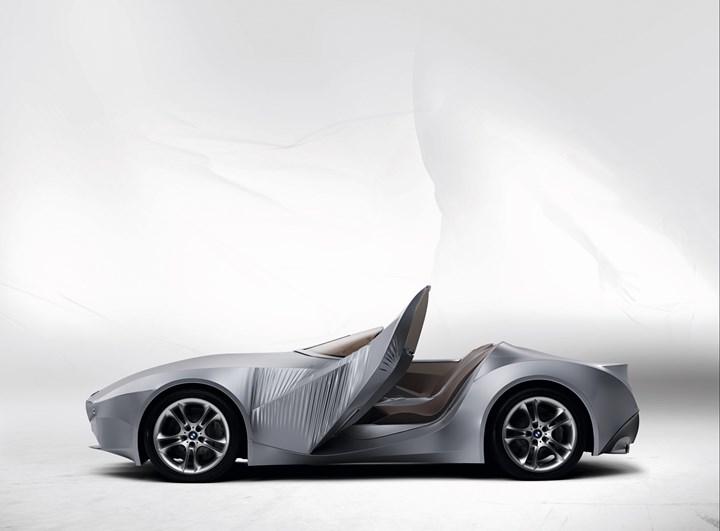
BMW Project GINA. Note the geometric body panel configurations. (Image: BMW)
In 2008 BMW Group Design unveiled a concept vehicle named “GINA Light Visionary Model” that was radical then—as now—for both its styling and because the vehicle is based on a moveable metal substructure that is able to reconfigure the exterior skin, which is made with what was described as a “special, highly durable and extremely expansion-resistant fabric.”
The body consists of four components: (1) from the front of the vehicle to the windshield, then down the sides to the rear edges of the doors (2 and 3) on either side of GINA from the front where the rocker panels are to the rear wheel arches; (4) the rear deck. Seems that using fabric rather than metal can simplify the number of parts needed.
Panels could be shifted around by electro- and electro-hydraulic control.
GINA (an acronym for “Geometry and Functions In ‘N’ Adaptions”), is highly, well, geometric in a way not seen even on a concept until now, with the Nissan Hyper Punk, a concept shown at the Japan Mobility Show last month.
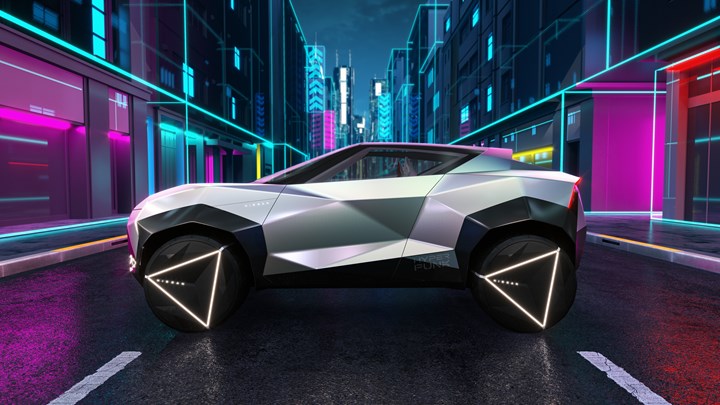
Nissan Hyper Punk concept: While it is hard not to look at the shapes of the wheels, look at the body panels. (Image: Nissan)
The electric compact crossover, “tailored for content creators, influencers, artists, and those who embrace style and innovation,” has “an exterior aesthetic defined by multifaceted and polygonal surfaces.”
Although GINA has physically changing body panels, Hyper Punk is painted with a silver coating that has tones “that shift depending on the viewing angle and light source.”
It has been 15 years since GINA first appeared. Will the Hyper Punk still seem radical in 2038?
///
2024 Dodge Hornet R/T Plus Blacktop EAWD
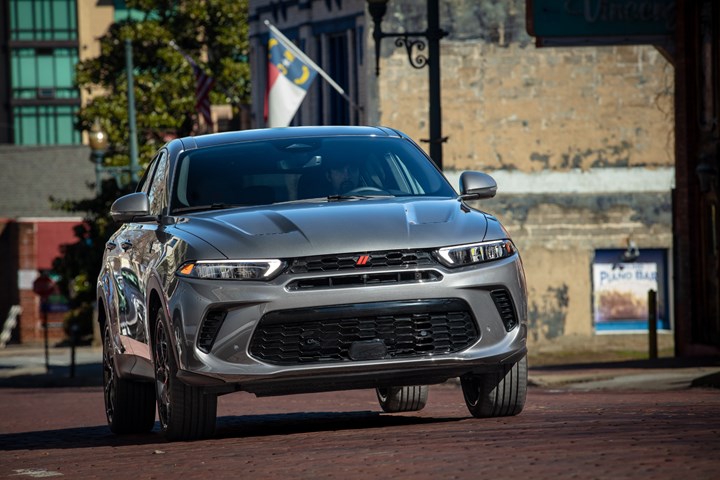
2024 Dodge Hornet: bringing the style. (Image: Dodge)
Speaking of design. . .
One of the things that is surprising about today’s mainstream compact crossovers—of which there seems to be an endless stream—is that with very few exceptions, there is a homogeneity of design. A tuck here, a twist there, and unless you can see the logo badge, it could easily be the case that you don’t know what brand you’re looking at.
There is also, again generally speaking, a certain consistency in the capabilities provided, as though there is some Master List of Compact CUV Characteristics that program managers have that they make certain their designers and engineers understand and execute: After all, if these attributes are what the market wants, then those attributes are what the market is going to get. But maybe there’s that tuck or twist.
The Dodge brand doesn’t have a whole lot going for it in terms of product in showrooms. For the past few years there have been the Charger and the Challenger and the Durango. Two cars and a mid-size SUV.
But one of the things that the folks at Dodge have done with their limited offerings is expand the bandwidth through pulling a variety of levers, from powertrains to in-your-face paint and graphics to clever packages.
It is, in effect, the “Go big or go home” ethos, one predicated on raw power and performance. Someone looking for subtlety can go over to the Chrysler side of the dealership and look at a 300 or a Pacifica.
But now there is the Hornet, a compact crossover.
While the marketing message about the vehicle coming out of the Auburn Hills HQ is that this is another sworn member of the Brotherhood of Muscle, I think it is far more than that.
The Hornet is quite simply a mainstream compact crossover with character.
Which makes it special simply because of that.
There are two versions of the Hornet. One that is a straight ICE model with a 2.0-liter turbocharged four-cylinder engine that produces 268 hp. And the other the one driven here, a plug-in hybrid that is equipped with a turbocharged 1.3-liter four that produces 177 hp but which is supplemented by two electric motors so that the system output is 288 hp.
Both vehicles are standard with all-wheel drive. The ICE-only vehicle has a nine-speed automatic and the plug-in hybrid a six-speed.
While I am charmed by the exterior design and amused but understanding of the interior, which combines eye-popping red and black materials (which explains the “Blacktop” edition nomenclature: this is a go-fast appearance), I found the hybrid powertrain to be somewhat less integrated that I would have liked. The estimated 33 miles of full electric driving is certainly nice to have, but once that’s gone the vehicle is rated at 21 city and 29 mpg highway (which is far from, for example, the EPA numbers for the Toyota RAV4 Prime plug-in, which offers an EV range of 42 miles and then 36/40 mpg).
But that said, it is rather stylish, which certainly matters.
Perhaps that goes back to the Brotherhood of Muscle notion. That cadre isn’t going to buy something that looks like most everything else. So the design of the Dodge Hornet delivers.
///
Rimac in Reverse
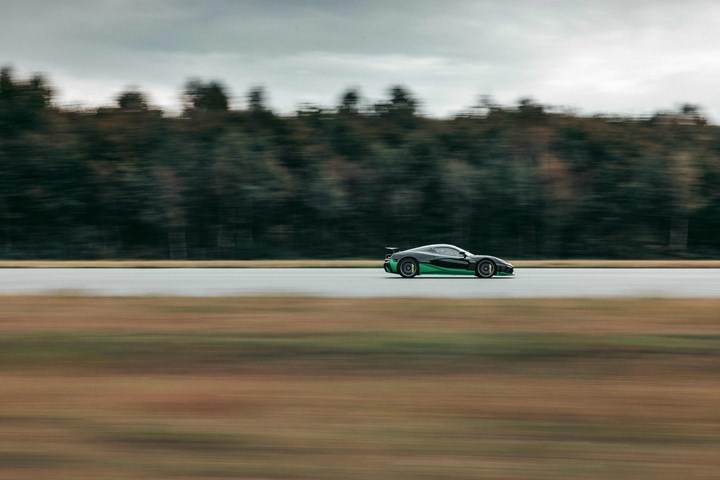
In July, the Rimac Nevera—a high-performance EV designed, engineered and produced in Croatia, a two seater with two 307-hp motors on the front axle and two 612-hp motors on the rear—participated in the Supercar Shootout at the Goodwood Festival of Speed and did the hill climb in a record 49.32 seconds, better than other production cars participating, regardless of powertrain.
In August the Nevera set a production-vehicle speed record on the shorter track at the Nürburgring, beating the previous record by 20 seconds. (It did the 12.8-mile track in 7:00:928.)
So what did it do most recently?
It went to the Automotive Testing Papenberg facility in northern Germany (where it broke more than 20 acceleration and braking record in a single day earlier this year) and set a Guinness World Record:
The fastest speed. . .in reverse.
Yes, 171.34 mph going backward.
As Goran Drndak, Rimac test driver put it:
“On the run itself, it definitely took some getting used to. You’re facing straight out backwards watching the scenery flash away from you faster and faster, feeling your neck pulled forwards in almost the same sensation you would normally get under heavy braking. You’re moving the steering wheel so gently, careful not to upset the balance, watching for your course and your braking point out the rear-view mirror, all the while keeping an eye on the speed. Despite it being almost completely unnatural to way the car was engineered, Nevera breezed through yet another record.”
Ah, yes. . . .
\\\
RELATED CONTENT
-
On The Jeep Grand Cherokee, 2022 Nissan Pathfinder, and More
An inside look at the Detroit Assembly Complex-Mack; a innovative approach to waste-free, two-tone painting; why a forging press is like an F1 car; and other automotive developments.
-
On Charging, Sustainable Tires, the Lincoln Nautilus and more
Charging at home, driving on plastic, cameras for exterior, Fisker and Foxconn, and the Lincoln Nautilus reviewed
-
On Traffic Jams, Vehicle Size, Building EVs and more
From building electric vehicles—and training to do so—to considering traffic and its implication on drivers and vehicle size—there are plenty of considerations for people and their utilization of technology in the industry.


.jpg;width=70;height=70;mode=crop)






